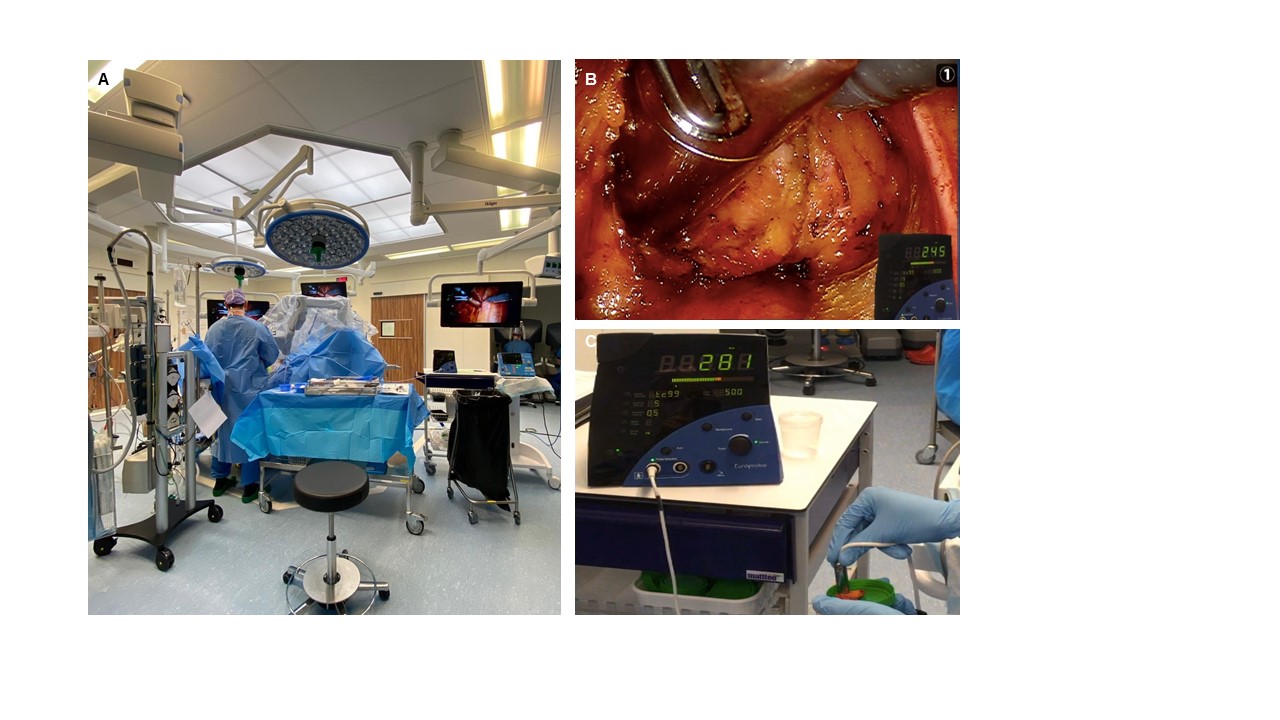Back
Poster, Podium & Video Sessions
Podium
PD27: Prostate Cancer: Localized: Surgical Therapy II
PD27-04: Robot-Assisted PSMA-radioguided Salvage Surgery in Recurrent Prostate Cancer Using a DROP-IN Gamma Probe - a Prospective Feasibility Study
Saturday, May 14, 2022
1:30 PM – 1:40 PM
Location: Room 255
Hilda de Barros*, Amsterdam, Netherlands, Matthias van Oosterom, Leiden, Netherlands, Maarten Donswijk, Jeroen Hendrikx, André Vis, Amsterdam, Netherlands, Tobias Maurer, Hamburg, Germany, Fijs van Leeuwen, Leiden, Netherlands, Henk van der Poel, Pim van Leeuwen, Amsterdam, Netherlands
- HD
Podium Presenter(s)
Introduction: Intraoperative Prostate-Specific Membrane Antigen (PSMA)-targeted radioguidance was proven to be valuable for the detection of PCa lesions during open salvage surgery. Rapid extension of robot-assisted, minimally invasive surgery has increased the need to make PSMA-radioguided surgery (RGS) robot compliant. Here we aim to evaluate whether the miniaturized DROP-IN gamma probe facilitates translation of PSMA-targeted radioguidance to salvage robotic surgery in men with recurrent PCa.
Methods: This prospective feasibility study (NCT03857113) included twenty patients with a biochemical recurrence (PSA = 0.2 ng/ml) after radical prostatectomy or radiotherapy with up to 2 pelvic PCa recurrences (either nodal or local) on PSMA positron emission tomography (PET)/CT. Patients received an intravenous injection of 99mTc-PSMA I&S (median activity 541 MBq, IQR 526-578) followed by scintigraphy as a control for tracer injection and distribution. Robot-assisted PSMA-RGS was realized using the tethered gamma probe 19-23 hours post-injection. The primary endpoint was the feasibility of PSMA-RGS in a robotic setting. Secondary endpoints were the comparison of the radioactive status (i.e., positive or negative) of the resected specimens and final histopathology results, the frequency of >50% prostate-specific antigen (PSA) reduction, complete biochemical response (cBR; PSA <0.2 ng/ml) 6 weeks postoperatively, and complications according to Clavien-Dindo 30 days postoperatively.
Results: At surgery, the median age was 68 years (IQR 66-72) and median PSA was 1.02 ng/ml (IQR 0.46-2.43). Using the DROP-IN probe, 19 out of 21 (90%) PSMA PET-avid lesions could be resected robotically with a median surgical duration of 128 min (IQR 103-157). On a per-lesion basis, the overall diagnostic sensitivity and specificity of robot-assisted PSMA-RGS was 86% and 100%, respectively. A >50% PSA reduction and cBR was seen in 12 out of 18 (67%) and 3 out of 18 (17%) patients, respectively. No Clavien-Dindo grade =2 complications occurred.
Conclusions: The DROP-IN probe helps to realize robot-assisted PSMA-RGS. The procedure is technically feasible for the intraoperative detection of nodal or local PSMA-avid PCa recurrences.
Source of Funding: Partly supported by an NWO-TTW-VICI grant (TTW 16141)

Methods: This prospective feasibility study (NCT03857113) included twenty patients with a biochemical recurrence (PSA = 0.2 ng/ml) after radical prostatectomy or radiotherapy with up to 2 pelvic PCa recurrences (either nodal or local) on PSMA positron emission tomography (PET)/CT. Patients received an intravenous injection of 99mTc-PSMA I&S (median activity 541 MBq, IQR 526-578) followed by scintigraphy as a control for tracer injection and distribution. Robot-assisted PSMA-RGS was realized using the tethered gamma probe 19-23 hours post-injection. The primary endpoint was the feasibility of PSMA-RGS in a robotic setting. Secondary endpoints were the comparison of the radioactive status (i.e., positive or negative) of the resected specimens and final histopathology results, the frequency of >50% prostate-specific antigen (PSA) reduction, complete biochemical response (cBR; PSA <0.2 ng/ml) 6 weeks postoperatively, and complications according to Clavien-Dindo 30 days postoperatively.
Results: At surgery, the median age was 68 years (IQR 66-72) and median PSA was 1.02 ng/ml (IQR 0.46-2.43). Using the DROP-IN probe, 19 out of 21 (90%) PSMA PET-avid lesions could be resected robotically with a median surgical duration of 128 min (IQR 103-157). On a per-lesion basis, the overall diagnostic sensitivity and specificity of robot-assisted PSMA-RGS was 86% and 100%, respectively. A >50% PSA reduction and cBR was seen in 12 out of 18 (67%) and 3 out of 18 (17%) patients, respectively. No Clavien-Dindo grade =2 complications occurred.
Conclusions: The DROP-IN probe helps to realize robot-assisted PSMA-RGS. The procedure is technically feasible for the intraoperative detection of nodal or local PSMA-avid PCa recurrences.
Source of Funding: Partly supported by an NWO-TTW-VICI grant (TTW 16141)


.jpg)
.jpg)